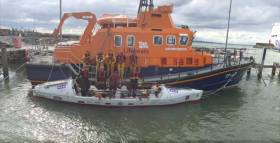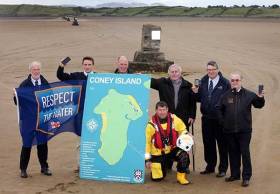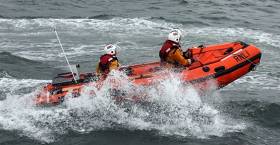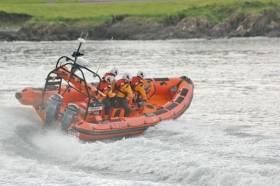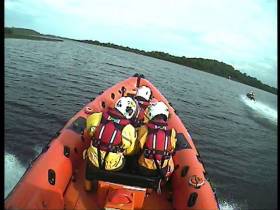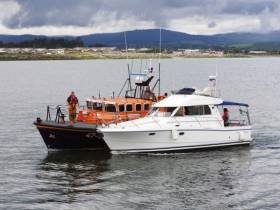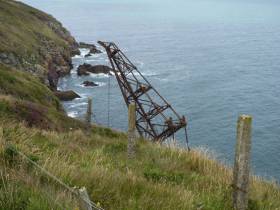Displaying items by tag: RNLI
Rosslare Harbour RNLI Launch to Four Rowers in Difficulty off Wexford Coast During Record-Breaking Attempt
Rosslare Harbour RNLI launched last night to four young men attempting a record-breaking row off the UK coast after they requested assistance in worsening weather conditions. They were brought to safety by Rosslare Harbour RNLI in a call out that lasted over six hours as the all-weather lifeboat towed the 24-foot rowing boat out of the channel and back to the safety of Rosslare harbour.
The four young rowers have had to set aside their record attempt after setting off from Tower in London 10 days ago to row around the UK coast. After leaving London they came up through Bristol channel and out into the open sea. However the weather was worsening last night and they found themselves battling the elements 22 miles off the Irish coast. Conditions were fresh with a north north-westerly wind gusting 25 knots. It was then hey made the decision to contact the Coast Guard and request help.
Volunteer lifeboat crew at Rosslare Harbour RNLI received the call at 6.15pm and launched in minutes. When on scene an hour later they checked if the young men were okay before establishing a tow and bringing the craft back slowly so as not to part the tow to the safety of Rosslare Harbour. The tow took six hours. The four rowers are currently being looked after in Rosslare before they decide on their next move.
Commenting on the call out Rosslare RNLI Lifeboat Operations Manager David Maloney said: ‘This call out was a good example of people recognising the importance of calling for help early when they realise they may be getting into difficulty. The group were dealing with worsening weather conditions and a changing tide which was taking them further from where they needed to be, all while they were mid-channel on a record attempt.’
However they didn’t let this sway them and raised the alarm bringing help. They had the right safety equipment and made a call quickly. If they had waited until things got worse and help was not close enough, it could have ended very differently. I have no doubt they will achieve any records they set their mind to in future.’
RNLI Launches Text Messaging Service to Prevent Dangerous Tidal Cut–Off at Coney Island in County Sligo
The RNLI has today launched an innovative free text message service aimed at preventing people getting caught out by dangerous tides when travelling to Coney Island in County Sligo.
In what is the first of its kind in Ireland, the RNLI text messaging service is being introduced by the charity in a direct response to a coastal safety risk identified by the local community in Sligo.
For years the causeway which provides access to Coney Island and the nature of its flooding tidal waters have presented a risk to the public who are unsure of the tide times and the appropriate times to cross from the mainland.
Sligo Bay RNLI has responded to numerous incidents around Coney Island that relate to tidal cut off and activities around the sandbanks and tidal channels. However, the volunteer lifeboat crews have often been restricted by water depth when attending these incidents especially during the crucial early phase of the flooding tide where people are starting to cut off or are bogged in.
It is hoped that the new text messaging system accompanied by signage directing people to the numbers to text, will encourage safer crossing and decision making.
Anyone planning to visit the island by car, bike or foot is encouraged to Text Coney to 53600 (from Republic of Ireland mobiles) or 81400 (from Northern Ireland/UK mobiles) to find out the safe crossing times for that day.*
The RNLI will reply with information on the best times subject to good weather conditions along with key safety messages reminding users to always leave extra time to return safely to the mainland, to never attempt to cross if the strand is covered with water and in the event of an emergency to dial 999 or 112 and ask for the Coast Guard.
Speaking at the launch of Text Coney today, Rogan Wheeldon, RNLI Community Incident Reduction Manager said: ‘This is a perfect example of a community on the coast identifying a risk and working collaboratively to help save lives at sea. By providing the public with the relevant information to make safer choices when accessing the coast it reduces their risk, the risk to our lifeboat crew, and also to those in the community that are putting their own lives at risk to help those in trouble’.
Joe Henderson, Sligo Bay RNLI Coastal Safety Officer added: ‘Over recent years our lifeboat crew at Sligo Bay RNLI has been called out many times to rescue people who have been caught out by the tide. As part of the RNLI’s work in prevention of accidental drowning we now have this wonderful texting system in place with good signage here at The Causeway and we really want to make people aware that is here and encourage locals and visitors alike to get texting when planning a visit to the beautiful Coney Island. We would like to thank everyone involved in bringing this development to fruition including the residents of Coney Island and Sligo County Council.’
The Text Coney launch comes a week after the RNLI launched Respect the Water, its annual national accidental drowning prevention campaign which will run throughout the Summer.
Respect the Water aims to highlight the risk of accidental drowning when people are near the coastline by encouraging safer behaviour both in and around the water.
The campaign is primarily aimed at males aged between 16 and 39 but the same advice is relevant for anyone visiting the coast.
The RNLI is warning of the key dangers that can lead to accidental drowning - cold water, unexpected entry into the water, and rip currents and waves.
Fethard RNLI launched this morning to a 21-foot fishing vessel with a fouled propeller one mile from Baginbun Head.
There was one fisherman on board the boat. While the lobster pots were being recovered onto the vessel a rope became tangled in the propeller and prevented the vessel from moving, leaving it stranded.
The lifeboat launched from Fethard dock in good weather with a northerly wind gusting 3/4 knots. Fethard lifeboat was on scene with the fishing vessel at 11.05am.
The volunteer lifeboat crew were able to release the rope and the fishing vessel came back to Fethard Dock under its own steam.
Speaking following the call out, Walter Foley, Fethard RNLI Lifeboat Operations Manager said: ‘The fisherman did exactly the right thing calling for the assistance of the RNLI. Weather conditions were good and allowed the volunteer crew to swiftly release the rope from the propeller allowing the fishing vessel to return under its own steam.’
Fethard RNLI volunteer lifeboat crew on the callout were Helm Thomas Stafford and Nicoletta Parrell, Dean Foley, Damian McGarry. The launch vehicle driver was Eileen Murphy.
Yesterday, US businessman and life long-sailor and entrant in tomorrow's Round Ireland Race, George David, met one of the men who saved his life off the Cork coast five years ago.
George’s 100 foot yacht, Rambler 100, capsized during the 2011 Fastnet Race. See photos of Rambler100's capsize here
George and seven other of the 21 crew members were hurtled overboard, where they remained stranded in freezing waters for over three hours.
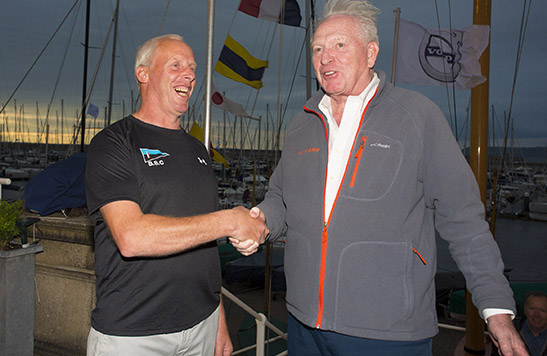
US businessman and life long-sailor, George David, pictured right with Pat Collins, one of the Baltimore lifeboat crew, who saved his life after his yacht capsized during the 2011 Fastnet Race.
Following a dramatic air and sea rescue by the Baltimore RNLI and the Irish Coastguard, George vowed that he would one day return to Ireland to compete in the 704-mile Volvo Round Ireland Yacht Race as a tribute to the people of Ireland.
He has come good on his promise and has arrived ahead of Saturday’s race start from Wicklow Bay with his latest racing boat, Rambler 88.
George joined the hundreds of crew from the record 64-strong Volvo Round Ireland fleet for a special welcome reception in Dún Laoghaire’s Royal Irish Yacht Club on Thursday evening.
He received a hero’s welcome, but remained philosophical about his experience:
“When you’re in trouble it is what it is. We had 21 people sailing and 21 people survived. We think about these things intellectually. It was very important that the entire team was amazingly calm in the face of adversity.”
Pat Collins was one of the Baltimore lifeboat team who rescued George and his crew. He recalled the difficulty in locating Rambler amid the foggy conditions on the evening: “Everything happened so fast. We were getting no response from Rambler. Five of the crew had drifted away and had spent hours in the water. The outcome could have been very different.”
George aboard Rambler is a strong contender to break the Volvo Round Ireland Race record of two days, 17 hours, 48 minutes and 47 seconds which was achieved by Mike Slade in ICAP Leopard 3 in 2008.
However George says that after many years in business he has learned to “under-promise and out-perform.”
“I have good expectations but actuals always exceed expectations. I would rather look back at a successful race than to promise something that might or might not happen. But I think we’re ready”
Race organiser Theo Phelan said George’s decision to return to Ireland for the 2016 Volvo Round Ireland is a huge honour for the race and for the people of Ireland.
“The efforts of the Irish rescue services in locating and bringing to safety George and his crew after three hours in the water, is a matter which raised his interest in finding a suitable offshore event for a return to the country for which he has enormous regard and appreciation.”
Red Bay RNLI Get All-Weather Lifeboat for Two Year Trial
An all-weather lifeboat has officially been put on service and become a declared search and rescue asset for a two year trial period at Red Bay RNLI in County Antrim.
The Trent class lifeboat Henry Heys Duckworth has come from the existing RNLI fleet and will now operate alongside the station’s existing inshore lifeboat.
Prior to its arrival in Cushendall, the lifeboat was moored at Glenarm Marina for a short period to facilitate the completion of shore works at Red Bay.
Today’s fully operational status for the all-weather lifeboat follows an intensive period of training for the station’s volunteer crew members.
The Henry Heys Duckworth was first launched in 1996 and since then has launched 200 times and rescued 217 people.
The decision to place an additional all-weather lifeboat on the North Antrim coast follows an in-depth review by the RNLI, of lifeboat cover in Northern Ireland.
Since the announcement last May there has been a concentrated period of preparation for the lifeboat crew, which has included months of training and visits to the RNLI College in Poole.
There are currently five coxswains, four mechanics, four navigators and a group of all-weather lifeboat crew members trained and ready to respond to call outs aboard the Henry Heys Duckworth.
Last year, Red Bay RNLI launched 20 times and brought 18 people to safety. Of those launches, 11 services were in the dark. In all, some 160 service hours were spent at sea.
Speaking as the lifeboat officially went on service this morning, Andrew McAlister, Red Bay RNLI Lifeboat Operations Manager said there was great excitement within the Cushendall community: ‘This is a proud day for everyone involved with Red Bay RNLI. The new lifeboat will allow us to provide lifesaving cover in all weathers and in challenging conditions up to 100 miles off the North Antrim coastline. To see this group of volunteers coming together and training with the all-weather lifeboat in recent months was wonderful and we are now fully prepared and equipped with the necessary training and skills to respond operationally alongside our inshore lifeboat.’
Developed by the RNLI in the early 1990s, the Trent class lifeboat is designed to lie afloat and is inherently self-righting. At sea, it is crewed by six all-weather lifeboat volunteers. It is capable of 25 knots and can carry up to 73 survivors.
The Trent carries an XP boat, an inflatable daughter boat with a 5hp outboard engine capable of six knots. She is used to access areas where the lifeboat cannot reach.
The comprehensive electronics include VHF and MF radios with DSC functionality, VHF direction finder, DGPS with electronic chart system and radar. Comprehensive first aid equipment includes stretchers, oxygen and entonox. Other equipment includes a portable salvage pump carried in a watertight container.
#RNLI - Bangor RNLI assisted four people who got into difficulty on a broken-down motorboat on Belfast Lough on Monday evening (13 June).
The volunteer lifeboat crew launched at 10.25pm to rescue the 19ft motorboat just off the Cloghan Jetty.
The boat, with four people on board, had lost all power and was drifting in fog close to the shore.
Arriving at the scene, guided only by the light from a mobile phone, the crew of the relief Bangor lifeboat Tabby Cat took the motorboat under its control and returned it and its and crew safely to Carrickfergus Marina.
Speaking following the callout, Bangor RNLI helm Peter Semple said: :The crew and I are delighted that we were able to return these people to the safety of the marina. Although it was a calm night, it was dark, and Belfast Lough is not a great place to be if you can’t be seen.
"It is important to ensure that, if you lose all power you still have some way of being seen and making contact with the shore."
In other news from Bangor, the lifeboat station was recently visited by a man rescued a fortnight ago by one of its volunteers after he suffered a heart attack at sea.
Tim Bailie was on a weekend pleasure cruise between Carrickfergus and Bangor with his family at the end of May when he was taken ill.
But thanks to the quick action of helm Kyle Edwards and his crew, Bailie is still here to tell the tale in his own words, as per the video below:
#RNLI - Carrybridge RNLI attended three different incidents – one involving a fire – on Upper Lough Erne this past Saturday (11 June).
The inshore lifeboat and rescue wafer craft were initially tasked to a burning vessel at 6.08pm, two miles north of Belturbet. Both Belturbet and the NI Fire and Rescue Service were in attendance.
The four people onboard were safely removed from the boat by a passing vessel and brought to shore. The 25ft Bayliner later burnt itself out and sank into shallow waters close to the shoreline.
The volunteer crew were then tasked by Belfast Coastguard to a boat with engine problems 1.5 miles from Knockninny. The sports cabin cruiser and its four passengers and their dog were brought to safety at Knockninny Marina.
The third tasking saw Carrybridge RNLI going to a vessel that ran out fuel close to the Share Centre. The 22ft vessel and its passenger were brought to safety of the Share Centre Marina.
The lifeboat and rescue craft returned to station at 9.15pm.
Speaking following the callouts, Carrybridge RNLI helm Chris Cathcart said: "The crew of the burning vessel did the right thing by alerting the coastguard straight way when their vessel went on fire.
"They made sure they had their lifejackets on and evacuated their vessel to another passing vessel as soon as possible."
Cathcart also commended the crews of the further two vessels the lifeboat assisted for their quick thinking when they found themselves in danger.
"The importance of alerting the coastguard as soon as possible in all cases help saves lives and prevented the situation from developing into something more serious on all our callouts."
The busy evening for the volunteer crew was in the first weekend of the RNLI’s summer campaign #RespectTheWater that targets accidental drowning along Northern Ireland’s coastline and inland waterways.
Respect the Water urges the public to watch out for the key dangers that can catch people out in or near the water. The campaign which will run throughout the summer months aims to highlight the risk of accidental drowning when people are near the water’s edge while encouraging safer behaviour both in and around the water.
Wicklow Lifeboat Assists Five On Motor Cruiser
#RNLI - Wicklow RNLI's all-weather lifeboat launched to give assistance to an English motor cruiser at 12.20pm yesterday (Sunday 12 June).
The cruiser, with five people on board, was on passage from Dun Laoghaire to Pembroke when it developed mechanical problems four miles south of Wicklow Harbour.
Just 15 minutes later, the lifeboat, under the command of coxswain Nick Keogh, was alongside the drifting cruiser. A towline was established and the volunteer crew brought the cruiser back to Wicklow.
This was the second callout out of the week for the Wicklow RNLI crew. On Wednesday morning, the all-weather lifeboat launched to assist a French yacht with three people on board that had its propeller fouled by a rope.
The crew of the yacht managed to free the rope obstruction and the lifeboat stood by until the yacht was able to resume its passage south.
Next Friday 17 June, Wicklow RNLI will hold a lifejacket clinic at the lifeboat station from 11am to 4pm in conjunction with the Round Ireland Sailfest.
Anyone who owns a lifejacket is encouraged to bring it along for a free check. Advice will also be available with tips on how to choose, fit and maintain your lifejacket.
Man Dies While Diving Off Waterford Coast
#Diving - A man has died after getting into difficulty while diving off Ardmore in Co Waterford yesterday afternoon (Sunday 12 June).
Youghal RNLI's volunteer lifeboat crew were tasked to the incident between Goat Island and Ram Head near Ardmore, Co Waterford before 4.30pm.
On arrival they found a man in the water who they recovered onto the lifeboat, and immediately administered casualty care.
Working with Helvick Head RNLI, who were also on scene, the casualty was winched onto the Irish Coast Guard helicopter Rescue 117 and brought to Waterford University Hospital, where he was later pronounced dead, as the Irish Examiner reports.
A spokesperson for Helvick Head RNLI that a second diver who had been with the deceased had managed to swim to shore to raise the alarm, allowing for a swift emergency response.
Commenting on the callout, Youghal RNLI lifeboat operations manager Fergus Hopkins said: "This was a difficult callout for everyone concerned and our thoughts are with the family of the man who was taken from the water this afternoon."
Portaferry Lifeboat Rescues Three Lost In Thick Fog
#RNLI - Volunteers with Portaferry RNLI went to the aid of three men on board a 4m dory who had become lost in thick fog close to Ballyhornan on the Co Down coast on Thursday (9 June).
At the time of launch at 4.45pm, the weather was extremely foggy with very poor visibility, a Force 2 southerly wind and smooth sea conditions.
The three men had become lost in the worsening conditions and were unsure of their exact location. Rather than try and guess their location, they called emergency services for help, giving a rough position as somewhere between Sheepland Harbour and Guns Island, just off the Co Down coast.
Portaferry RNLI headed towards the men’s general location and at first passed the three men in the thick fog. On arrival at Sheepland Harbour, however, the lifeboat crew started to track back towards Guns Island.
By this time the men on board the lost vessel had called the coastguard once more to report that they had heard the engines of the lifeboat passing by, helping to pinpoint their location.
The lifeboat crew arrived on scene close to Guns Island at 5.15pm, attaching a tow rope and proceeding to tow the boat into Ballyhornan Bay, where the three men went safely ashore before the lifeboat returned to station.
Following on the rescue, Portaferry RNLI lifeboat operations manager Brian Bailie said: "The three men made the correct decision when they called for help.
"They had become lost and disorientated in thick fog and rather than try to blindly find their own way to shore, they called for help and remained in the area they last believed they were.
"This made our job a lot easier and I am delighted that our volunteer crew have helped bring these men safely to shore."



























